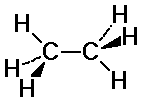Organic Chemistry I |
Chapter 3 Notes |
Professor Carl C. Wamser |
![]()
Organic Chemistry I |
Chapter 3 Notes |
Professor Carl C. Wamser |
![]()
![]()
Conformations
Ethane Conformations
C-H bonds on the two carbons may or may not align
eclipsed: C-H bonds are aligned ![]()
staggered: C-H bonds fit in between 
Newman Projections
Potential Energy Diagrams
Butane conformations
Molecular mechanics
Types of strain:
Ring strain
Heats of combustion (normalized per CH2 unit)
Small cycloalkane conformations
Cyclohexane
Monosubstituted cyclohexanes
PRACTICE DRAWING ACCURATE CHAIR FORMS WITH SUBSTITUENTS
equatorial generally preferred over axial
see the table in the text with delta G for axial vs equatorial
Disubstituted cyclohexanes - cis & trans isomerism
Depending on the substitution pattern, disubstituted cyclohexanes have different combinations of axial and equatorial substituents.
|
|
|
|
|
|
|
|
|
|
|
|
|
|
|
|
Example - the two chair conformations for cis-1-chloro-3-methylcyclohexane involve either two axial substituents or two equatorial substituents. The latter is more stable.
All substituents prefer equatorial over axial
Polycyclic Compounds
spirocyclic - one carbon atom in common to two rings
naming: spiro[m.n]alkane (m,n are bridge sizes, where m<n)
number starting next to the common (spiro) atom as #1, go around smaller bridge firstexample: spiro[2.3]hexane
bicyclic - two carbon atoms in common to all three rings (bridgehead positions)
naming: bicyclo[x.y.z]alkane (x,y,z are bridge sizes, where x>y>z)
number starting at one bridgehead atom as #1, go around bridges in size order (x>y>z)example: bicyclo[3.2.0]heptane
Heterocyclic Compounds
contain one or more atoms in the ring that are not carbon
naming: special names for every case (covered later with the corresponding functional groups)
example: piperidine
![]()